The Wellington City Council says the bill to clean up the damage from Thursday's violent storm could stretch into seven figures.
The storm was the capital's strongest in 27 years, with waves at the harbour entrance peaking at 15 metres, three metres higher than seas during the Wahine disaster.
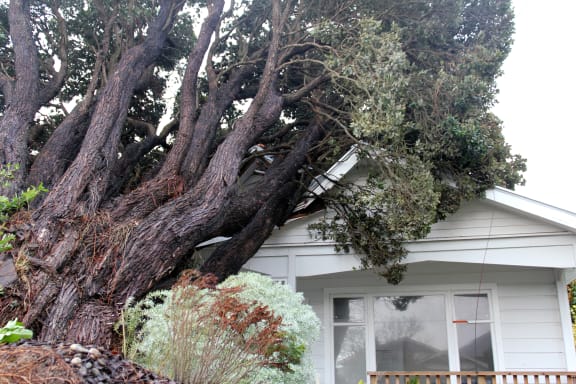
A fallen tree damaged the roof of a Lower Hutt house. Photo: RNZ
Winds reached 200km/h at Mount Kaukau in the suburb of Khandallah and 142 km/h at Wellington Airport at the storm's height on Thursday night, MetService said. Waves reached nine metres on parts of the east coast of New Zealand.
Air New Zealand said although flights resumed from just after midday on Friday, there was a massive backlog and strong winds contributed to delays. Ferry sailings have been halted.
Wellington Electricity said at least 2000 households and businesses in Wellington, the Hutt Valley and Porirua were without power late on Friday night due to damage caused by high winds and torrential rain. At the peak of the storm, about 30,000 homes and businesses were affected.
The lines company said some rural customers would remain without power for most of the weekend as repair crews struggle to fix power lines in difficult conditions. It asked customers to be patient and to treat all lines as live and dangerous. Spokesperson Drew Douglas said he would like to remind people to check on the wellbeing of neighbours and the elderly.
Porirua mayor Nick Leggett said about 500 properties are expected to be reconnected by midnight on Friday. Mr Leggett is asking those with power to invite family and friends without electricity to stay the night to keep warm.
Wellington City Council spokesperson Richard MacLean told Radio New Zealand's Checkpoint programme on Friday fallen trees that have snapped power lines are slowing progress.
Mr MacLean said the council received more than 200 calls from frightened residents on Thursday. "We've got multiple reports of trees down, power lines down, we've got reports about houses losing roofs, broken windows, structural damage and all sorts of problems."
Public transport in Wellington is likely to be disrupted for days, with many of the region's roads and some rail lines out of action.
Meanwhile, about 300 properties in Taranaki, Whanganui, Wairarapa and Taihape face the night without power. Lines company Powerco said it has restored electricity to 2500 out of 2800 customers cut off on Thursday night. It said fallen trees are responsible for a large proportion of the outages.
View a gallery of storm images
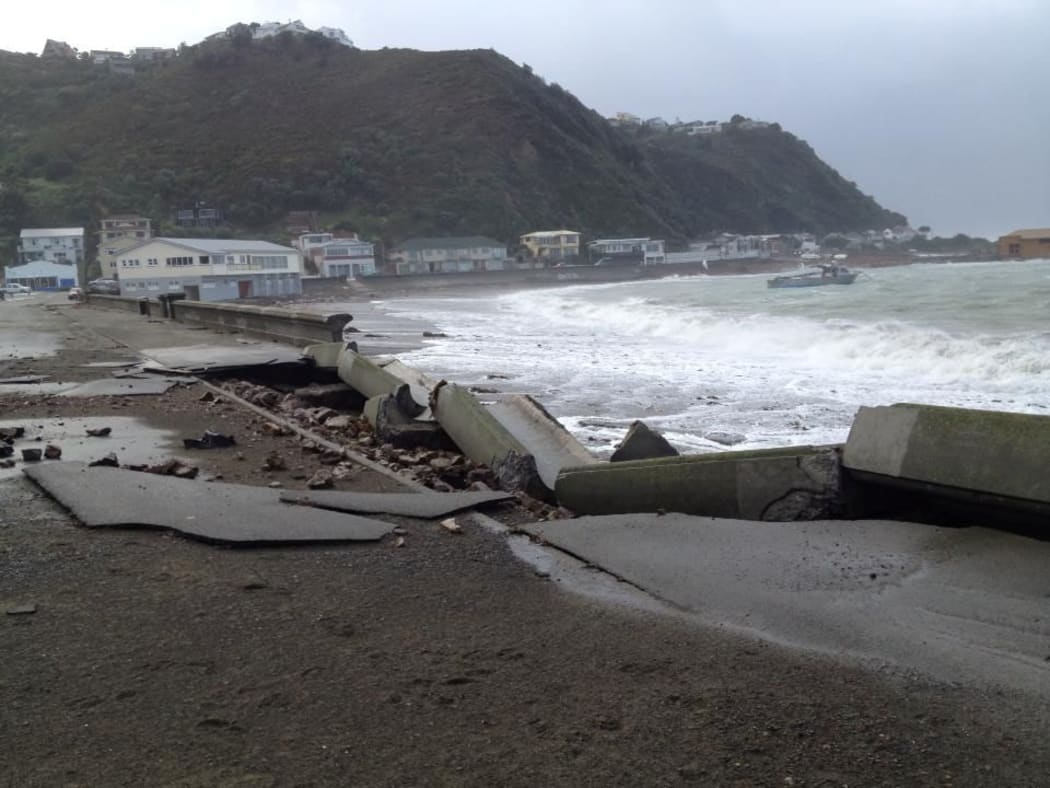
The sea wall at Island Bay in Wellington was smashed. Photo: Pete van Berkel
'Worse than Wahine'
People living on Wellington's south coast have compared the gales to the 1968 Wahine storm as powerful swells pushed seaweed and logs onto seaside streets and into garages.
A resident of Owhiro Bay, Jean, said she was in Wellington during the Wahine storm and Thursday's was worse. "It's a lot rougher the waves are bigger, the wind is incredibly strong."
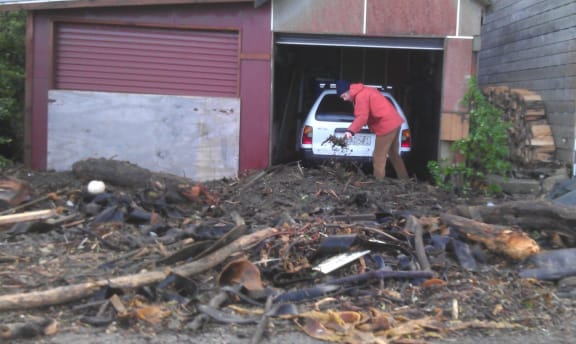
Debris washed up in front of south coast properties. Photo: RNZ
Another resident, Richard, said the sea came up to his garage door and pushed around parked cars on his street.
A Radio New Zealand reporter said people in the coastal suburb were scrambling to dislodge cars stuck on the street in debris and get them to safety before high tide at 2pm.
Fire Service shift manager Murray Dudfield said crews had responded to 585 callouts in the lower North Island in the 12 hours to 6am on Friday, most related to damage caused to buildings, including roofs being blown off and windows blown in. Mr Dudfield said properties on Wellington's south coast were worst hit, with residents in Kingston, Melrose, Island Bay and Lyall Bay particularly affected.
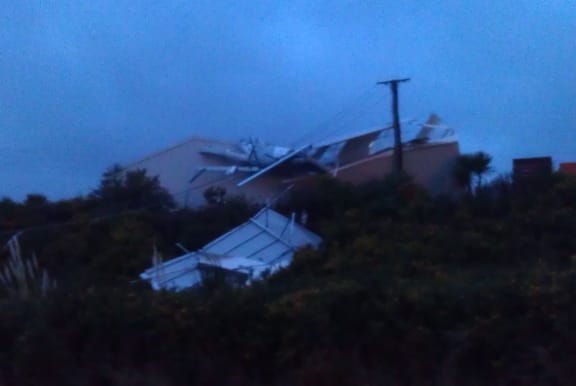
A storage shed in Grenada North was severely damaged. Photo: RNZ
Wellington Mayor Celia Wade-Brown said the council is assessing the damage and there will be a huge operation to clean up after the storm. She said one of the houses damaged in the slip in Kingston three weeks ago has lost part of its roof.
Radio New Zealand staff member Sandra Cody said the roof of her house in the southern Wellington suburb of Melrose had begun lifting, along with that of her neighbours.
An industrial building in Grenada North, north of Wellington, that stored scaffolding equipment was severely damaged. The shed was made of steel and built this year and its owner said it will have to be entirely replaced.
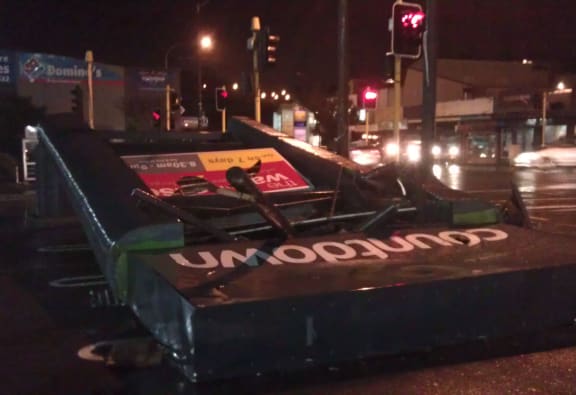
A supermarket sign was toppled onto a carpark in Johnsonville. Photo: RNZ
The wind caused Interislander ferry Kaitaki to break its moorings on Thursday evening forcing it to go out into the harbour. Wellington Harbourmaster Mike Pryce said two tug boats stayed overnight with the vessel which had about 50 crew on board.
At Seaview Marina in Petone, the wind forced a steel cradle holding a large ketch in dry dock to bend, puncturing the yacht as it fell on its side. Marina chief executive Alan McLellan said at least one other yacht has a broken mast and several others have ripped sails and broken windows.
The bad weather has also taken a toll on seabirds. Wellington Zoo said it is treating eight injured birds including three albatrosses. Some of the birds are just exhausted, while others have badly grazed feet due to crash landings.
Transport disrupted
Bus and train services are disrupted in Wellington, but Civil Defence and police said drivers coped extremely well during rush hour on Friday, despite high winds still buffeting the capital.
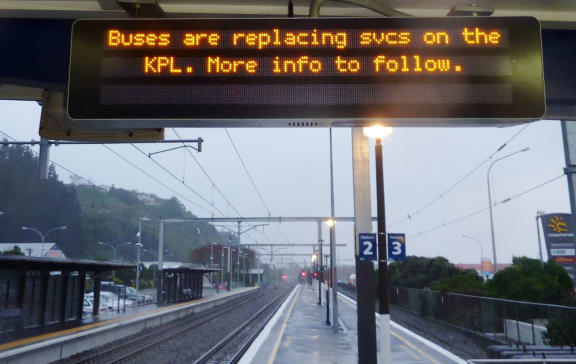
Photo: RNZ
Civil Defence regional controller Bryan Pepperell said it is a blessing that despite significant damage to homes, roading and electricity, there has been no loss of life during the storm.
Highways in the Wellington area were open, but several other roads have been closed by slips, fallen trees and other debris.
They include: Normandale Road near Lower Hutt, Paekakariki Hill Road, Middleton Road near Johnsonville, Makara Road at Karori and Grays Road at Plimmerton. Marine Drive in Eastbourne is closed to all but residents.
Trains on the Melling line have been cancelled on Friday night, but the Kapiti line was to reopen about 6pm. Trains on the Hutt Valley line would be disrupted into next week.
School bus services were cancelled and a number of schools and kindergartens throughout the region were closed on Friday.
Desert Road closed
Snow has again closed the Desert Road on Friday night. The section of State Highway 1 between Rangipo and Waiouru was reopened for just a few hours after being shut overnight on Thursday.
Other central North Island highways are open, but caution is required due to snow.
Houses damaged in Auckland lightning strike
High winds and thunderstorms hit northern-most parts of New Zealand on Thursday. More than a dozen homes in and around the Auckland were damaged when lightning brought down trees about 10pm.
The Fire Service said a tree fell on two houses in the suburb of Glen Innes, and one person was believed to have suffered minor leg injuries. Houses were damaged, and windows shattered in Whangaparaoa, north of the city, when trees were struck by lightning.
MetService said it had recorded wind gusts of 110km/h in western parts of Northland and at Manukau heads near Auckland.

